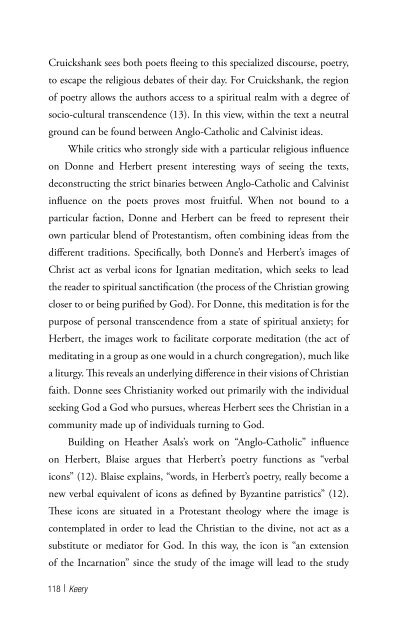Untitled - California State University, Long Beach
Untitled - California State University, Long Beach
Untitled - California State University, Long Beach
Create successful ePaper yourself
Turn your PDF publications into a flip-book with our unique Google optimized e-Paper software.
Cruickshank sees both poets fleeing to this specialized discourse, poetry,<br />
to escape the religious debates of their day. For Cruickshank, the region<br />
of poetry allows the authors access to a spiritual realm with a degree of<br />
socio-cultural transcendence (13). In this view, within the text a neutral<br />
ground can be found between Anglo-Catholic and Calvinist ideas.<br />
While critics who strongly side with a particular religious influence<br />
on Donne and Herbert present interesting ways of seeing the texts,<br />
deconstructing the strict binaries between Anglo-Catholic and Calvinist<br />
influence on the poets proves most fruitful. When not bound to a<br />
particular faction, Donne and Herbert can be freed to represent their<br />
own particular blend of Protestantism, often combining ideas from the<br />
different traditions. Specifically, both Donne’s and Herbert’s images of<br />
Christ act as verbal icons for Ignatian meditation, which seeks to lead<br />
the reader to spiritual sanctification (the process of the Christian growing<br />
closer to or being purified by God). For Donne, this meditation is for the<br />
purpose of personal transcendence from a state of spiritual anxiety; for<br />
Herbert, the images work to facilitate corporate meditation (the act of<br />
meditating in a group as one would in a church congregation), much like<br />
a liturgy. This reveals an underlying difference in their visions of Christian<br />
faith. Donne sees Christianity worked out primarily with the individual<br />
seeking God a God who pursues, whereas Herbert sees the Christian in a<br />
community made up of individuals turning to God.<br />
Building on Heather Asals’s work on “Anglo-Catholic” influence<br />
on Herbert, Blaise argues that Herbert’s poetry functions as “verbal<br />
icons” (12). Blaise explains, “words, in Herbert’s poetry, really become a<br />
new verbal equivalent of icons as defined by Byzantine patristics” (12).<br />
These icons are situated in a Protestant theology where the image is<br />
contemplated in order to lead the Christian to the divine, not act as a<br />
substitute or mediator for God. In this way, the icon is “an extension<br />
of the Incarnation” since the study of the image will lead to the study<br />
118 | Keery<br />
of the incarnate Jesus, the ultimate material symbol representing God<br />
(12). Herbert’s concrete depictions of specific images, such as Christ’s<br />
passion, present the reader with a mental image to contemplate and acts<br />
as a religious icon leading to contemplation of the divine. These images<br />
are verbal in that they are made with words and meant to be sensually<br />
experienced through the eyes and ears. They are icons in that they are<br />
concrete images for the purpose of facilitating Christian worship. 3<br />
The idea of verbal icons can be extended to Donne’s poetry as well<br />
because, in Holy Sonnets, he too presents concrete images, which work to<br />
lead the reader to a state of spiritual transcendence. Cruickshank argues<br />
that both Donne and Herbert were “incarnationalists” since “their poetics<br />
took account of the pressure of sensible things on abstract thought, and<br />
used that pressure to shape an imaginative response . . . They rather treat<br />
the synergy of outward and inward as a productive one, bearing the<br />
imprimatur of the Incarnation itself” (1). This idea works along with that<br />
of verbal icons: a physical icon is a sensual experience of the material with<br />
the purpose of guiding the mind to the spiritual, non-material. Verbal<br />
icons use sensory language in order to present the image which works<br />
in the imagination guiding the mind to higher, spiritual thoughts. Both<br />
Donne’s and Herbert’s iconic images are primarily of Christ, thus doubly<br />
working with ideas of incarnation—depicting the Incarnate Christ and<br />
calling on a perfect combination of spiritual and physical in the image<br />
itself. It is this melding of focus on the outward image and inner spiritual<br />
state which allows Donne and Herbert to blend Anglo-Catholic and<br />
Calvinist influences.<br />
“Holy Sonnet XIII” portrays Donne’s use of verbal icons. The speaker<br />
says, “Mark in my heart, O soul, where thou dost dwell, / The picture<br />
of Christ crucified” (2-3). In these lines, the verbal icon is presented in<br />
“Christ crucified,” and the reader is to “mark” this image. One meaning<br />
for “mark” is “to make the sign of the cross” upon oneself (OED). When<br />
Keery | 119
















